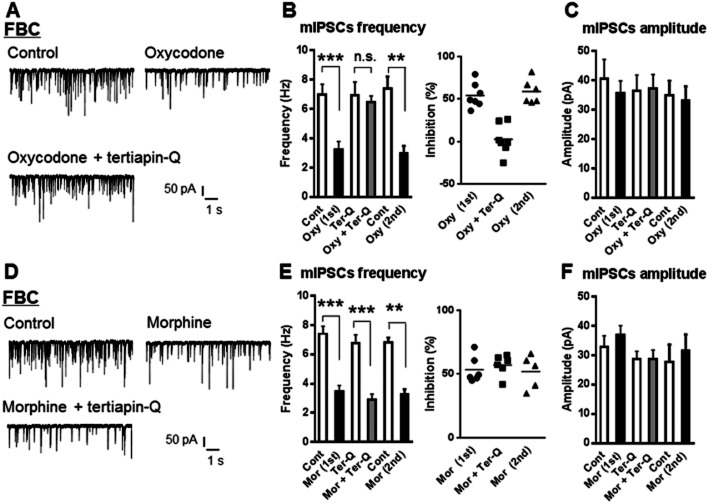Figure 8.
The Kir3.1 channel inhibitor tertiapin-Q abolished the inhibitory effect of oxycodone, but not that of morphine, on GABAergic mIPSCs frequency in VLPAG neurons of the FBC model. (A) A representative trace showing that oxycodone (10 μM) caused inhibition of mIPSCs frequency in a VLPAG neuron from the FBC model, which was completely abolished by tertiapin-Q. (B) Left panel, a summary of inhibition of mIPSCs frequency by oxycodone (10 μM) in the FBC model and its disruption in the presence of tertiapin-Q. Each column represents means ± SEM (n = 7). The asterisk indicates a statistically significant difference between pre- and post-treatment with oxycodone alone groups, as determined by paired t-test (two-tailed, **P < 0.01, ***P < 0.001). Right panel, the extent of inhibition of mIPSCs frequency by oxycodone in the presence of tertiapin-Q and oxycodone alone. The inhibitory effects of tertiapin-Q on the oxycodone-induced reduction of mIPSCs frequency were reversible because a second (2nd) application of oxycodone alone again reduced mIPSCs frequency, to a similar extent as the first (1st) application of oxycodone. (D) A representative trace showing that morphine (10 μM) caused inhibition of mIPSCs frequency in a VLPAG neuron from the FBC model, which was not abolished by tertiapin-Q. (E) Left panel, a summary of inhibition of mIPSCs frequency by morphine (10 μM) and no disruption of morphine-induced inhibition in the presence of tertiapin-Q. Each column represents means ± SEM (n = 6). The asterisk indicates a statistically significant difference between pre- and post-treatment with morphine in the presence of tertiapin-Q and morphine alone, as determined by paired t-test (two-tailed, **P < 0.01, ***P < 0.001). Right panel, extent of inhibition of mIPSCs frequency by morphine in the presence of tertiapin-Q and morphine alone. (C) and (F) Summary graphs showing that the amplitude of mIPSCs in VLPAG neurons was not changed by oxycodone and morphine in the absence and presence of tertiapin-Q.

